

One of the lasting effects of the long pandemic has been the change in corporate attitudes towards remote work. What was once considered a perk for a select few employees – the opportunity to telecommute – has become a standard mode of operation for a majority of US enterprises.
For our latest CIO Insight call, we invited Stanford economist Nick Bloom to engage with our panel of distinguished tech leaders. There is probably no person better qualified to explain changes in our approach to work from home (WFH) than Dr. Bloom, whose research team surveys 5,000+ US working age adults and 1,000+ firms each month. Much of this data can be found on his website, WFH Research.
Key Insights:
Work from Home is Here to Stay
During the pandemic lockdown, WFH soared from an average of 5 percent of employees working at least one full day per week at home to more than 60 percent. Now that the latest wave of the pandemic has subsided and offices have re-opened, US organizations are settling at around 25 percent WFH. That’s a 5X increase in just two years.
The WFH numbers in the UK and Northern Europe are pretty similar. They’re a little lower in the less developed countries in Africa, Asia, South America, and Southern Europe, because the industrial structure and home facilities don’t permit it. The biggest variations are across industries. The more computer-based jobs, particularly in tech and finance, tend to have higher WFH levels than, say, construction, agriculture, or retail.
Hybrid Work is the New Model for Professionals
Obviously, WFH varies greatly by occupation. Front-line and lower paid employees are more likely to be fully on site; specialized roles like IT support and payroll are more likely to be fully WFH.
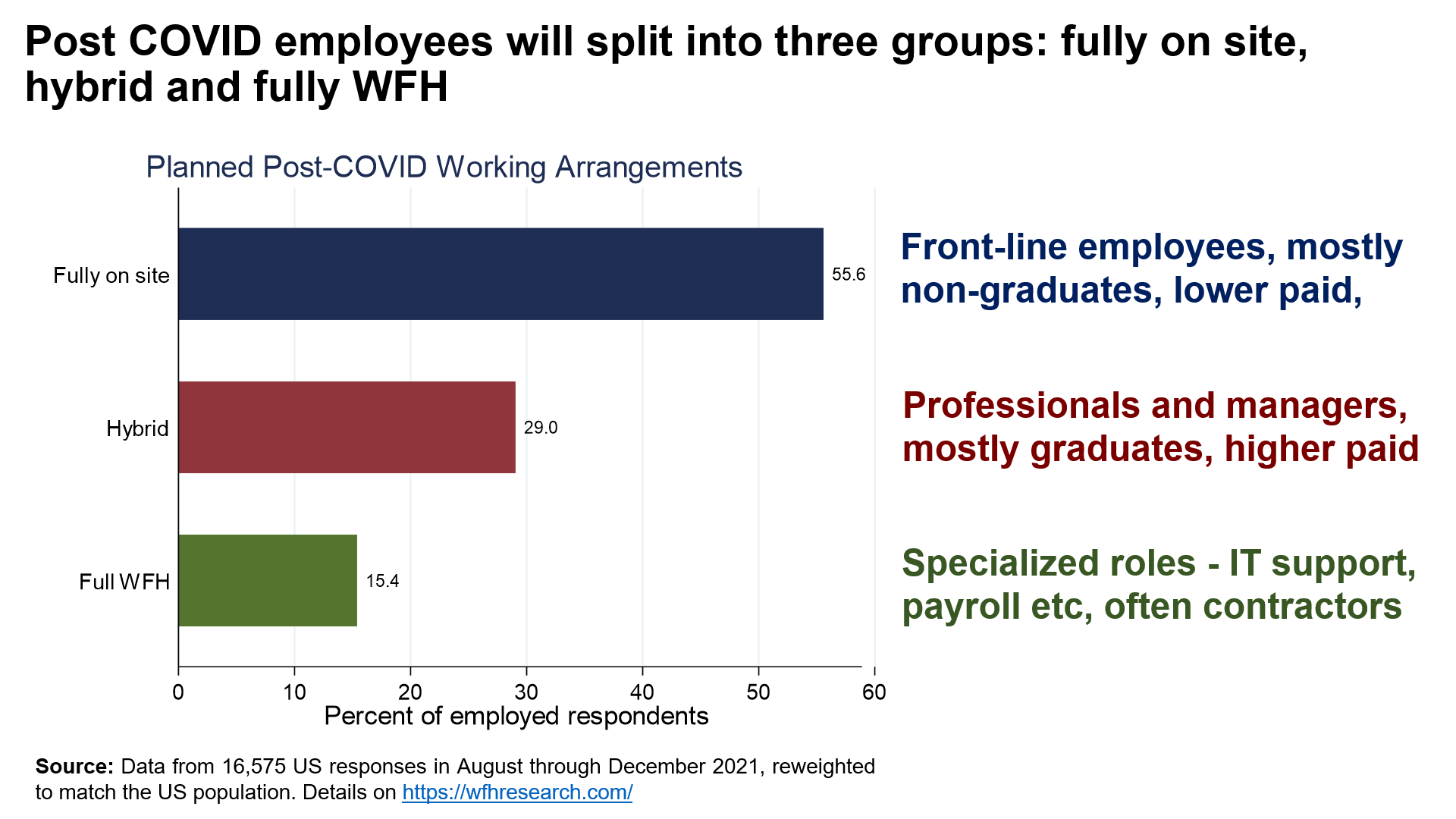
But the highest paid roles — managers and professionals — are likely to adopt a hybrid strategy, where they are in the office 3 days and at home 2 days (or vice versa).
Hybrid Combines the Best of Both Worlds
Working in the office is better for building culture and enhancing collaboration; working from home is better for concentration and recapturing time spent commuting. Employees report that avoiding commutes saves them 70 minutes a day on average, and they spend 40 percent of that time doing more work. That translates into productivity gains of around 3 to 5 percent.
A lot of those productivity gains are self reported, which can be problematic. But even if productivity is essentially equivalent at home or in office, the positive impact WFH has on recruiting and retention is more than worth it.
Employees are Demanding WFH
A big driver for WFH is that employees want it – and if you don’t offer it, they’ll find someone who will. More than 40 percent of employees say if they’re required to come back 5 days a week they will either quit or start looking for another job. Just as important, many highly paid professionals see flexible working arrangements as an extremely attractive perk.
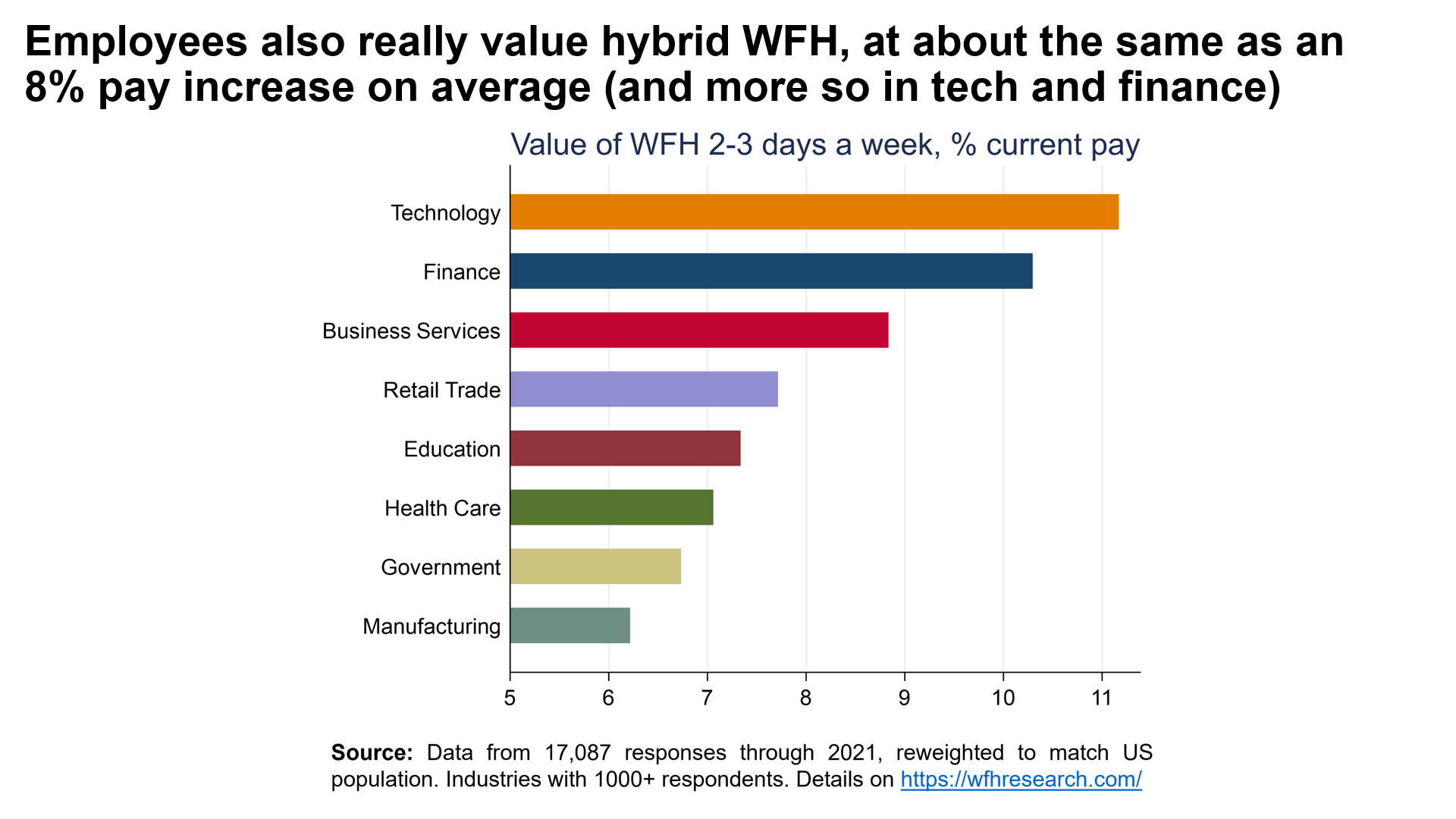
Overall, employees value a WFH option as equivalent to an 8 percent pay raise; that rises to just over 11 percent for technology workers. And if you want employees to come in full time, you’ll probably have to pay them 10 to 20 percent more. The option to work remotely, at least part time, is becoming essential for recruitment and retention.
WFH is a Boon for Enterprise Diversity Programs
Preferences for WFH are not the same across all demographics. Demand for flexible work locations is highest among women and people of color. For example, women favor working at home on an average of nearly 2.5 days a week (or roughly twice what most employers were planning to offer). Men indicated a slightly smaller preference for WFH, but were more likely to be offered that option than women.
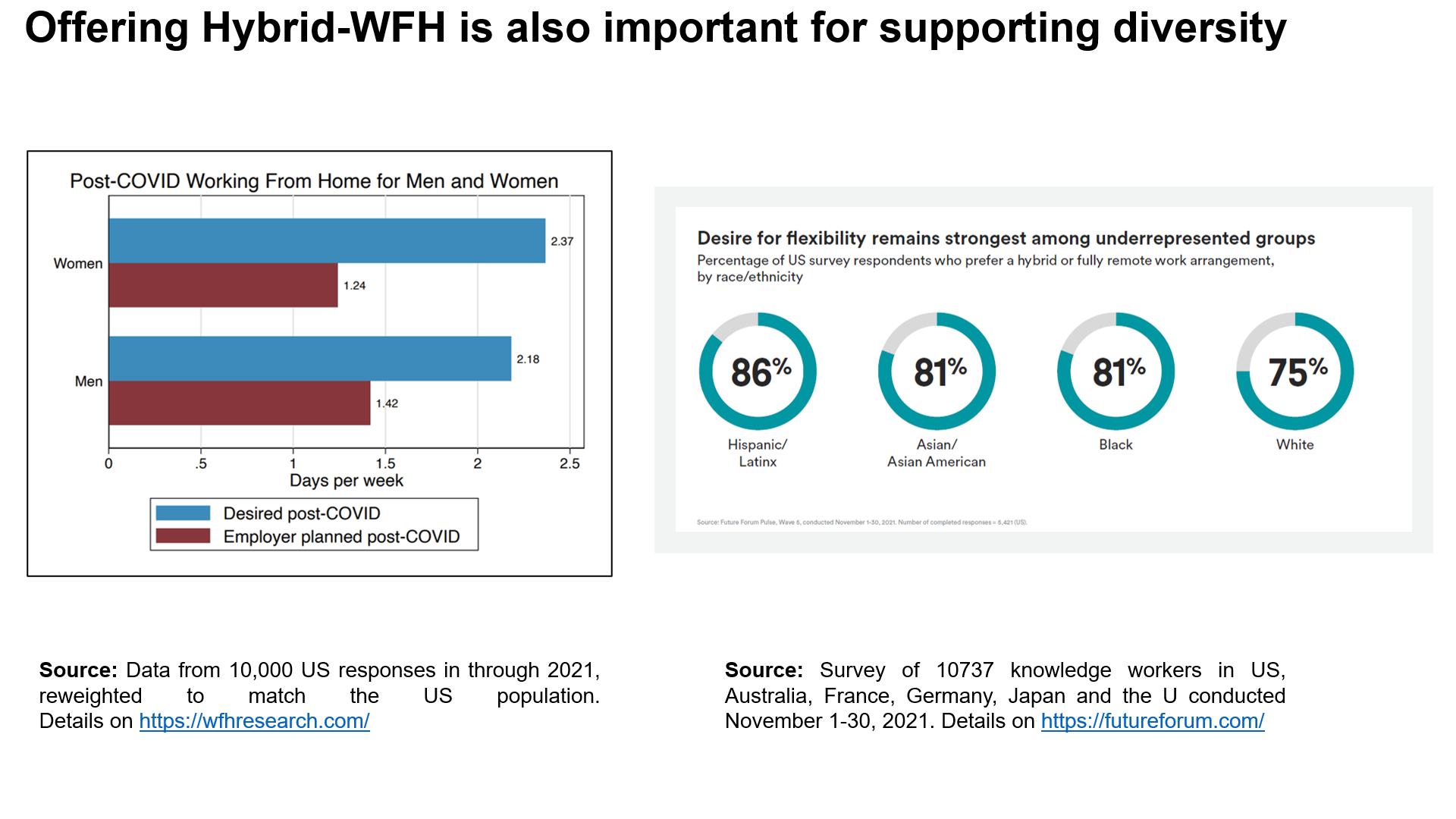 In other surveys, Hispanic, Asian, and Black knowledge workers were more likely to look favorably upon flexible work schedules. This means that if you’re planning to require employees to come into the office five days a week, as Goldman Sachs has announced, you’re likely to see excessive attrition of these demographics, which can be quite damaging to diversity efforts.
In other surveys, Hispanic, Asian, and Black knowledge workers were more likely to look favorably upon flexible work schedules. This means that if you’re planning to require employees to come into the office five days a week, as Goldman Sachs has announced, you’re likely to see excessive attrition of these demographics, which can be quite damaging to diversity efforts.
Business Leaders Should Choose Days Where Everyone Can Be Present
Figuring out when to have employees in the office is the biggest challenge facing employers. Four out of five workers say the biggest benefits of being in the office are socializing and increased face time — neither of which applies if some employees are in person while others are remote.
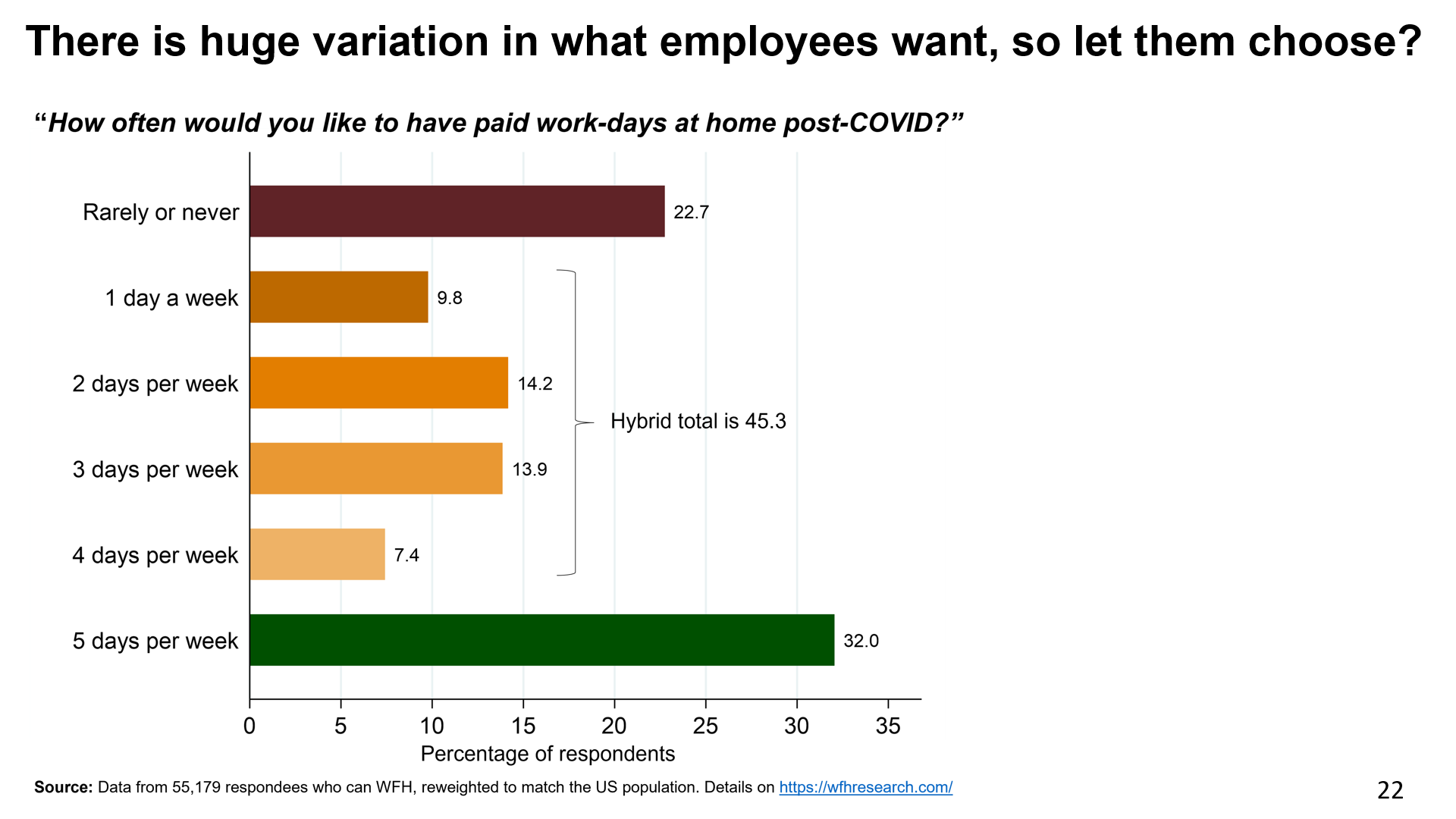
CxOs will be faced with difficult decisions when trying to balance the needs of employees who want to be fully remote (32 percent) vs those who want to be fully in the office (23 percent), as well as which days hybrid workers will be required to come in. Allowing employees to choose for themselves is a probably not a viable strategy.
Mandating days where everyone on a particular team needs to be in office – like, Monday-Tuesday-Thursday, as Apple has done – seems to be most efficient way of going about it, but there’s no one-size-fits-all solution. If you have teams where some employees are fully remote and others are hybrid, Bloom advises that you give the remote workers six months to adapt to coming into the office at least part time. Some may leave, but it’s better if they depart now than stay and be unhappy over the long term.
Cost Savings on Real Estate Will Be Minimal
The pandemic came with dire warnings about a collapse in the commercial real estate market. But, in fact, leased space is unlikely to shrink by more than a few percentage points. That’s because offices – which are already empty on nights and weekends — will still have people in them most weekdays. What will change is how floor plans are laid out: fewer individual offices, larger collaborative spaces, more places for people to hold private Zoom calls.
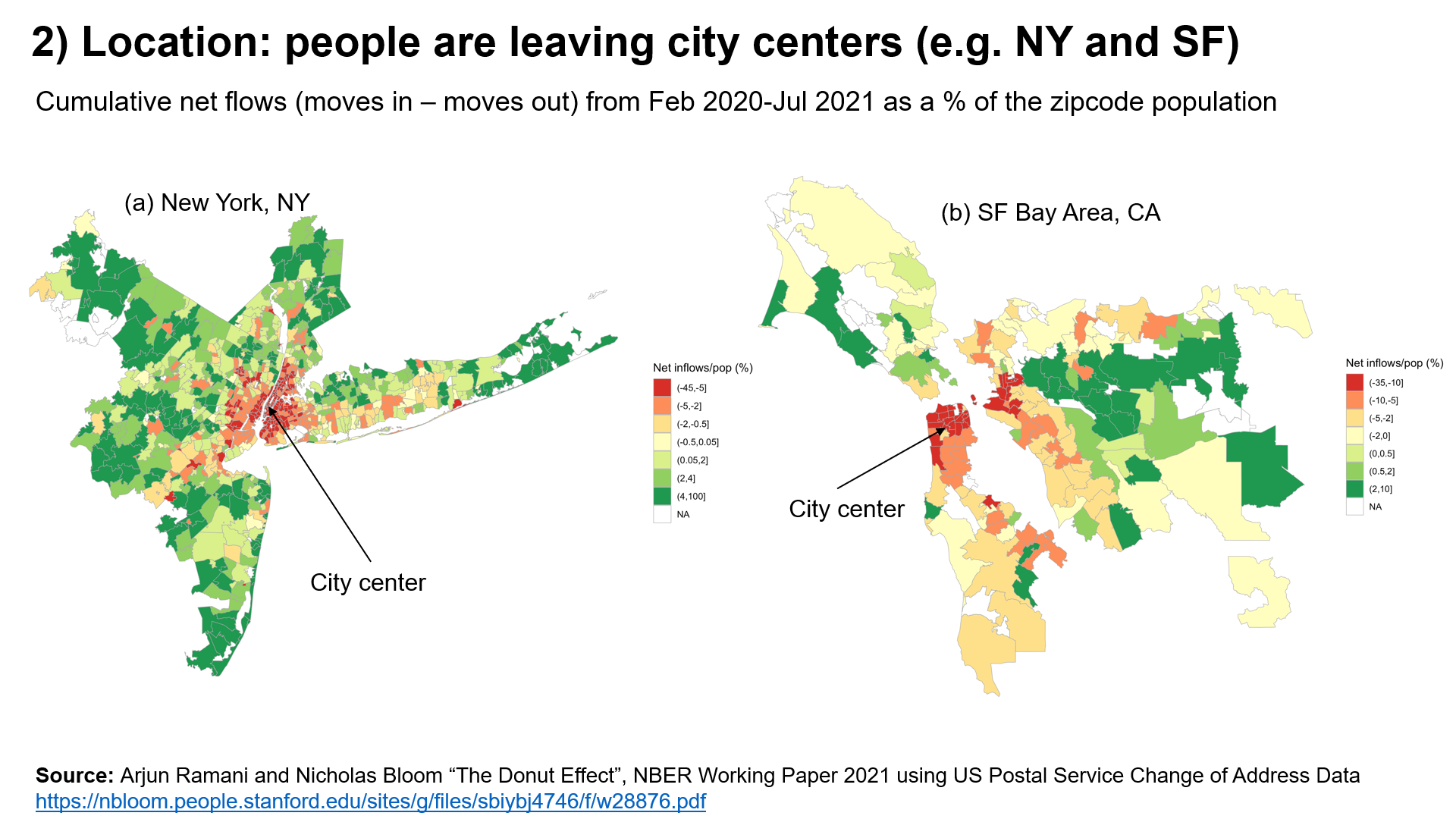
Hybrid work arrangements will also change where employees live, but not radically. People are flowing out of city centers and into surrounding areas, where they can get more house for their money. The reason: Employees are willing to endure a longer commute if they only have to do it a few times a week, but they still want to come into a nice place to work.
More Changes Will Be Needed
As more enterprises adopt remote-friendly work policies, they’ll need better performance management systems to get more accurate measurements of productivity. Managers will have to be trained to avoid ‘presenteeism’ bias, where employees who show up get favorable treatment for compensation and promotion. We’ll also continue to need improvements in technology infrastructure that levels the field between in-house and remote employees.
The Future Will Be At Least Partially Remote
Some companies — like Upwork, Quora, and Automattic, to name just three — are going fully remote. The upside: It saves them 20 percent on office overhead, and makes it easier for them to recruit globally. The downside is a loss of face time and creativity, as well as probably higher attrition rates.
Most organizations will go hybrid. Very few will require their personnel to be in the office full time. That appears to be a very fast way to lose a lot of employees.
